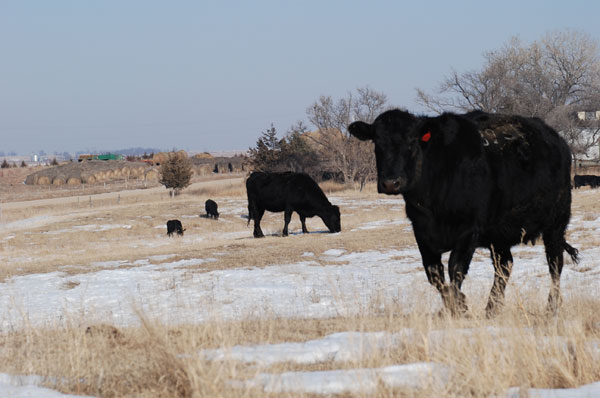Of course, it’s easier to spend time indoors in the winter months, but we didn’t choose this lifestyle because it would be easy. And the cows always need to be fed.
December 14, 2017

Commentary; By Bruce Derksen
When winter and spring conditions turn on a dime—and they will—cattle producers realize their daily routines and tasks will be greatly modified. Likely more than any other occupation, those who deal with agriculture in the great outdoors should understand they need to be flexible, focused and proactive when it comes to Mother Nature and the conditions she throws at them.
If our cowherds can’t survive and be productive or our feedlot cattle can’t gain weight, it impacts the negative side of the spread sheet. Likewise, if our horses can’t operate safely, or myself as a pen rider can’t do a proper job, we are adding to the minus column.
There is nothing worse for a rancher than not to be able to properly check his pregnant cows because he can’t get to them due to heavy, wet snows, or a pen rider who can’t accurately check feedlot cattle because old Sonny can’t slog through the mix of ice, thawing snow and soupy, heavy manure. Yes, we can’t control the weather, but we can control how we handle its offerings when we have the chance.
For a rancher, it is essential his pregnant cows have an adequate place to give birth. When a cow or heifer requires assistance, you don’t want to be forced to help her in adverse conditions. Access to a calving barn or shelter is extremely important.
The same applies in a feedlot. If cattle struggle to reach the feedbunk or water bowl because they have to slog through thick, sloppy, brown soup, at best they will make fewer trips. At worst, they will become sick, and their fewer trips will turn into zero trips. Of course, sickness in a feedlot pen is contagious and a few sick cattle will become many sick cattle.
And it’s not just the cattle that will be negatively impacted. Horses will not be able to operate and be productive in deep snow or slushy pens. It is extremely hard on their legs and joints to be expending the extra energy needed just to walk in this type of environment, never mind attempting to work cattle.
What about working on foot in poor winter conditions? Us old pen riders hate to climb down off our mounts at the best of times, but if you’ve ever tried to pull a sick steer in knee deep slop, or move a cranky cow through snow banks that’s trying to calve, you know what I mean. You can quickly find yourself standing bootless in your socks, with limited to no mobility, dirty ice water oozing between your toes while you face down this angry cow or steer that can’t navigate either, and that suddenly thinks it might be fun to plant you in said snow bank or half frozen bed of manure. No one wants that.
The modern, progressive cattle producer needs to do their due diligence and be proactive. Use technology and monitor the weather trends. We can be prepared to deal with what it offers.
Of course, it’s easier to spend time indoors in the winter months, but we didn’t choose this lifestyle because it would be easy. Take advantage of cold weather and plow away those snow banks from the calving area before the spring chinook hits and it becomes too soft to run a tractor over. If you are experiencing a spring thaw, scrape water bowl and feed bunk pads while they are soft before that cold snap returns.
Instead of complaining about the negative conditions winter and spring can bring, take advantage of the opportunities and push the positives. Add to that side of the spread sheet. You’ll be able to safely move that heifer to the barn where you can assist her when she’s struggling to calve. Pen riders will be able to pull that sick steer efficiently without worrying about knee deep slop or someone or something getting hurt.
Being engaged, focused and proactive will pay off in better profits, efficiency, productivity and overall health for all involved. And last of all, old Sonny will thank you as he and I continue to make our way around a cleaner feedlot pen.
Derksen is a freelance writer and longtrime feedyard pen rider from Lacombe, Alberta, Canada.
You May Also Like



